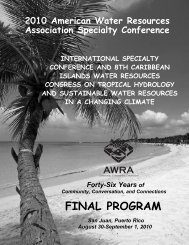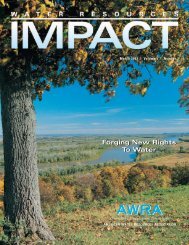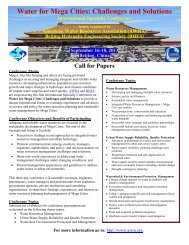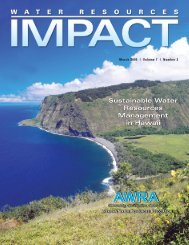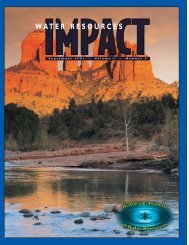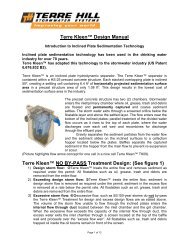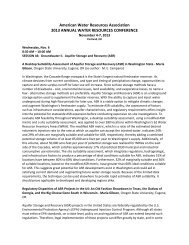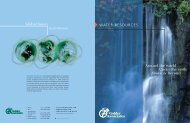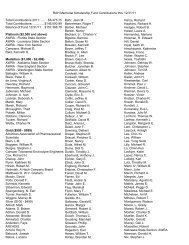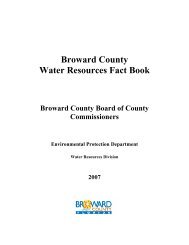N ovember 2 0 0 0 ⢠V olume 2 ⢠N umber 6 - American Water ...
N ovember 2 0 0 0 ⢠V olume 2 ⢠N umber 6 - American Water ...
N ovember 2 0 0 0 ⢠V olume 2 ⢠N umber 6 - American Water ...
Create successful ePaper yourself
Turn your PDF publications into a flip-book with our unique Google optimized e-Paper software.
MSU-WATER<br />
(WATERSHED ACTION THROUGH EDUCATION AND RESEARCH)<br />
Scott G. Witter, Ruth Kline-Robach, Fred Poston, and Michael J. Lang<br />
The Challenge: “As we look at the twenty-first century,<br />
several challenges face us. Foremost among them is how<br />
to satisfy the food, drinking water, sanitation, and health<br />
needs of the ten or twelve or fifteen billion people, when<br />
we have failed to do so in the world of five billion” (Peter<br />
Gleick from <strong>Water</strong> in Crisis, 1993).<br />
INTRODUCTION<br />
In Michigan, where access to abundant supplies of<br />
fresh water is a reality, it is often difficult to think of<br />
water as a scarce or threatened resource. Some individuals<br />
throughout the state, nation, and world still believe<br />
that ample sources of clean water will always be available.<br />
However, the general public is becoming more attuned<br />
to today’s increasing water quality problems resulting<br />
from both point and nonpoint source pollution.<br />
The closing of beaches due to high E. coli levels and the<br />
contamination of ground water supplies because of high<br />
nitrate leaching have served as warnings that everyone<br />
should be concerned with the potential degradation of<br />
one of our most precious resources, water.<br />
Across Michigan, surface water quality<br />
standards have been routinely exceeded.<br />
The City of Lansing has historically<br />
released more than 1.3 billion gallons<br />
of untreated wastewater to the<br />
Grand River every two years (Witter and<br />
Godbold, 1999). Local public health standards<br />
for partial and full body contact<br />
recreation are exceeded on the Grand<br />
River over half the year in the Lansing<br />
vicinity. In Ingham County alone, where<br />
Michigan State University (MSU) is located,<br />
there are more than 3,700 miles of<br />
drainage ditches and pipes that could potentially allow<br />
nonpoint source pollution to enter the surface waters<br />
(P. Lindemann, August 2000, personal interview with the<br />
Ingham County Drain Commissioner).<br />
Upstream of Lansing, the community of Williamston<br />
has been faced with high levels of E. coli pollution at their<br />
new $800,000 whitewater kayaking facility, prompting<br />
the Ingham County Environmental Health Department to<br />
post health advisories for potential users. Further upstream,<br />
smaller communities have been found to be releasing<br />
raw sewage directly into the Red Cedar River<br />
(R. Godbold, September 2000, personal interview with<br />
the Director of Ingham County Enviornmental Health Department).<br />
Downstream of MSU, the City of Lansing’s<br />
Public Works administrators have characterized the<br />
Sycamore Creek, a tributary of the Red Cedar River, as<br />
being an open sewer during parts of the year. Annualized<br />
costs for water quality protection in the Rouge River in<br />
MSU-WATER<br />
will serve the needs of<br />
Michigan communities<br />
by developing affordable,<br />
practical solutions to<br />
current water quality<br />
problems<br />
Detroit, Michigan, were estimated to be $10,000 per day<br />
during its Phase I activities (Murray et al., 1998).<br />
MSU, which is located in the Red Cedar River <strong>Water</strong>shed,<br />
has recognized the importance of the water resources<br />
that flow through the University’s campus in<br />
East Lansing, Michigan, and has made the commitment<br />
to lead through example by designing a watershed management<br />
initiative that will strengthen its education program,<br />
expand its research opportunities, and focus on<br />
community outreach. The initiative, <strong>Water</strong>shed Action<br />
Through Education and Research (MSU-WATER), will include<br />
an assessment of campus resources, the development<br />
of a watershed management plan, and the construction<br />
of a series of water management demonstration<br />
sites on campus. These sites can be used to help villages,<br />
cities, developers, industries, and other stakeholders<br />
from across the state, nation, and world to learn how to<br />
best manage their water resources and protect our collective<br />
future.<br />
As part of the Land Grant University system, MSU<br />
has played a lead role in managing and increasing agricultural<br />
land resources and production. An emphasis on<br />
protecting water resources on a watershed<br />
basis should be a welcome challenge<br />
for the Land Grant Universities.<br />
While all of the universities in the Land<br />
Grant University system have faculty and<br />
staff with expertise in water resources issues,<br />
we have been unable to identify an<br />
institution that has adopted a watershed<br />
management approach for its own campus.<br />
Historically, universities have hired<br />
consulting firms to complete the assessments<br />
and write a management plan.<br />
MSU has chosen instead to invest in the<br />
long-term by creating a multidisciplinary team of faculty<br />
and students who can, through their expertise, not only<br />
develop the plan, but also create unique teaching, research,<br />
and outreach opportunities. Projections show<br />
that this can be completed at a lower cost and with significant<br />
buy-in and ownership by the faculty and students.<br />
MSU'S GUIDING PRINCIPLES AND PROMISE<br />
MSU has made a strong commitment to “extend its<br />
national and international prominence in research, creative<br />
arts, and graduate and graduate/professional education,<br />
through selective investment in programs of distinction<br />
and unusual promise. MSU will be an exemplary<br />
engaged university, transforming and strengthening<br />
outreach partnerships to address key Michigan needs<br />
and developing broadly applicable models” (President<br />
V<strong>olume</strong> 2 • N<strong>umber</strong> 6 <strong>Water</strong> Resources IMPACT • 19



